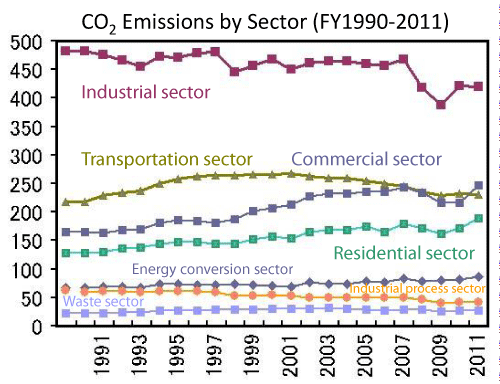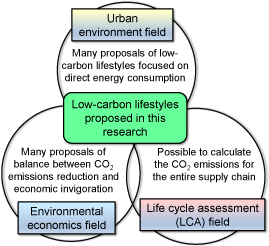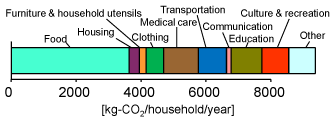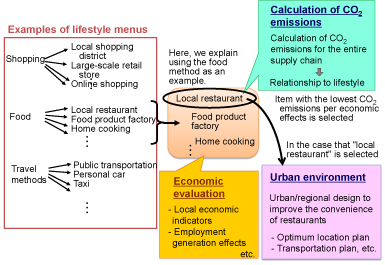
Research Article
Austin J Earth Sci. 2015;2(1): 1009.
Development of Measures for Urban Environment Planning and Evaluation Aimed at Realizing Low-Carbon Lifestyles
Hirano Y1*, Yoshida Y2 and Watanabe S3
1Center for Social and Environmental Systems Research, National Institute for Environmental Studies, Japan
2Graduate School of Environmental Studies, Nagoya University, Japan
3Faculty of International Human Studies, Suzuka International University, Japan
*Corresponding author: : Yujiro Hirano, Center for Social and Environmental Systems Research, National Institute for Environmental Studies, 16-2, Onogawa, Tsukuba, Ibaraki 305-8506, Japan
Received: February 01, 2015; Accepted: March 10, 2015; Published: March 12, 2015
Abstract
Converting from mass-production/mass-consumption lifestyles to lowcarbon lifestyles is important for the establishment of a low-carbon society. Although much research has been conducted, mainly in the urban environment field, on human behavioral factors in energy consumption, much of this research has been focused only on direct energy consumption by people in their daily lives. In reality, because energy consumption of the industrial sector is extremely high compared to that of the residential, commercial and transportation sectors, reducing CO2 emissions from industrial activity is the key to large reductions in CO2 emissions. Moreover, because global warming countermeasures that suppress consumption behavior may induce economic downturns, it is imperative that consideration also be given to invigorating the economy and securing employment. Therefore, we are conducting research to develop a method for designing urban environment systems that achieves a balance between CO2 emissions reduction and economic invigoration. The aim is to shift industrial structure gradually by leading it toward conversion to lowcarbon lifestyles. With this method, it could be expected that a balance between CO2 emissions reduction and economic invigoration might be achieved without a heavy burden of cost or suppression of consumption. This method incorporates a life cycle CO2 emissions reduction scenario into research on low-carbon urban environment planning, which has conventionally been focused on the residential, commercial and transportation sectors. Furthermore, because the method gradually shifts industrial structure toward industries with low-carbon lifestyles through lifestyle conversion, it can be said to provide a soft landing for the transformation from a mass-production/mass-consumption society.
Keywords: Low-carbon society; Lifestyle; Life cycle CO2; Urban environment
Introduction
Although numerous studies have been conducted on the establishment of a low-carbon society, the actual amounts of CO2 reduction thus far achieved cannot be considered sufficient; thus, there is a need to relate research to provide future policies that are more viable [1,2]. In establishing a low-carbon society, an important issue is shifting from a wasteful lifestyle in a mass-production/massconsumption society to a low-carbon lifestyle [3,4]. Many of the educational activities aimed at the general public, such as campaigns encouraging no-carbon lifestyles and electricity conservation, are based on knowledge obtained from these studies (e.g., Team Minus 6%, Challenge 25 campaign, Fun to Share campaign [5]). However, most of this effort has been focused only on direct energy consumption by people in their daily lives (e.g., air-conditioning, private cars, hot water supply), and does not address CO2 emissions by the industrial sector, which causes a high percentage of CO2 emissions. In reality, reducing CO2 emission from industrial activities is extremely important for conversion from mass-production/mass-consumption lifestyles to low-carbon lifestyles because energy consumption in the industrial sector is extremely high, compared to that in other sectors [6] (Figure 1). Moreover, global warming countermeasures that suppress consumption may lead to economic deceleration. Because economic invigoration is a large incentive for local governments, it is difficult to implement measures that reduce CO2 emissions by controlling consumption. Therefore, it is imperative that consideration be given to invigorating the economy and securing employment. In order to generate employment, policies have been made for encouraging investment in global warming measures under concrete government guidance (e.g., local Green New Deal funds in Japan [7]). However, this also generates costs, and thus, the lower the economic capacity of a local government body, the more difficult it is to introduce such measures on a large scale. In particular, for measures such as solaror wind-generated electricity, where the percentage of initial costs is high, there might be an outflow of wealth into regions with factories. Thus, it cannot be denied that regions that introduce such equipment are likely to become increasingly economically impoverished.

Figure 1: Trends in CO2 emission in each sector in Japan (prepared based on the National Greenhouse Gas Inventory [6]).
Therefore, there is an urgent need to formulate proposals that reduce overall life cycle CO2 emissions for residential, commercial, transportation and industrial sectors, as well as to construct urban environment systems for realizing such lifestyles. Thus, this paper introduces proposals for new urban environmental-planning and evaluation measures.
Summary of Previous Research and Proposed Method
Numerous studies have been conducted on low-carbon and energy-conservation lifestyles in the field of urban environment research, mainly in architecture, civil engineering, and urban engineering [8-10]. Most of the activities recommended focus only on direct energy consumption by people in their daily lives (e.g., changing air-conditioner settings and promoting the use of public transportation), and normally targets only the residential, commercial, and transportation sectors. However, the reality is that the energy consumption of the industrial sector is extremely high compared to that for the other sectors. Thus, reducing CO2 emissions from industrial activity is the key to large reductions in CO2 emissions. In this field of research, there are many studies of industrial sector measures, and on CO2 emissions from the perspective of factories [11], but there is a lack of information from the perspective of consumers.
Research that assesses CO2 emissions in the industrial sector from the perspective of consumers is conducted in the life cycle assessment (LCA) field of research. In this field, CO2 emissions resulting from the production of various industrial products are estimated for the entire supply chain based on Input Output tables [12,13]. Using these estimation results, the relationship between consumer behavioral patterns and indirect CO2 emissions is also analyzed [14]. Because this enables the calculation of CO2 emissions resulting from the production of various industrial products for the entire supply chain, it is possible to understand the relationship between life cycle CO2 emissions and consumer lifestyles. At this stage, such knowledge has generally been established, and the number of implementations in the real world is gradually increasing. (e.g., the CFP program [15]: the environmental housekeeping book, Ecohana). Such cases have enabled provision of information (visualization) of CO2 emission levels when products are purchased. They are also beneficial information for supporting voluntary, environmentally friendly behavior among consumers that are highly environmentally conscious. However, in order to tie these measures to concrete government-led policies, it is necessary to consider their impact on the economy also. In reality, because suppressing consumption may have adverse effects on the economy, it is difficult to implement government-led policies that suppress consumption while attempting to reduce CO2 emissions.
Striking a balance between reduction of CO2 emissions and economic invigoration is an important theme in the field of environmental economics. As a result, a number of pertinent economic models and evaluation methods have been established. However, in many of the measures proposed, the policy is to stimulate the economy with global warming countermeasures, thereby balancing reduction of CO2 emissions and economic invigoration [16,17]. In brief, these policies seek to establish a balance between CO2 emissions reduction and employment generation. However, it is also necessary to consider the need for other agents to bear the burden of cost. In other words, because these policies are mechanisms by which employment is generated through the implementation of expensive global warming countermeasures, it is necessary to consider the actual burden on household budgets and public finance. This approach has the unavoidable effect of limiting implementation. In many cases, for the more effective global warming countermeasures related to generating employment, the costs are generally higher. Therefore, it is difficult to implement large-scale policies to reduce CO2 emissions.
From such background, it can be seen that, although the information from each field has advantages and disadvantages, it is evident that they are also mutually complementary. Therefore, this paper proposes measures that tie together the three research fields that have thus far been discussed individually (Figure 2).

Figure 2: Summary of previous research and positioning of proposed methods.
Proposal for Urban Environment Planning and Evaluation Measures
We are conducting research to develop a method to solve such problems by transforming industrial structure while simultaneously transforming lifestyles. In other words, it is important to encourage lifestyle transformations that gradually lead to a shift in industrial structure, toward industries with low carbon emissions that are highly effective in generating local employment. A typical example would be a transformation from a lifestyle dependent on manufacturing industries to a lifestyle dependent on service industries that have low carbon emissions in relation to their economic ripple effect. If such lifestyle-guidance policies were to be implemented under the direction of local government bodies, it is highly likely that a balance could be established between generation of local employment and reduction of CO2 emissions, without generating a burdensome cost or curbing consumption. Such policies could provide incentives for many local government agencies.
Estimates of CO2 emissions from direct energy consumption linked to daily life and behavioral patterns and those from indirect energy consumption related to the consumption of industrial goods and services, calculated based on their entire supply chain, are shown in Figures 3 and 4, respectively. In this study, CO2 emissions caused by electricity consumption were included in direct CO2 emissions in order to differentiate CO2 emissions caused by electricity consumption from indirect CO2 emissions accompanying the consumption of industrial goods and services. CO2 emissions from direct energy consumption (Figure 3) were calculated using utility cost expenditure data collected by the Household Expenditure Survey and energy prices collected by the Retail Price Survey and broken down into energy uses based on climate conditions and urban conditions by using the estimation method of Hirano et al. [18]. Indirect CO2 emissions (Figure 4) were calculated using CO2 emission intensity [12] and Household Expenditure Survey data. These figures indicate that indirect CO2 emissions exceed the CO2 emissions from direct energy consumption. For the CO2 emissions accompanying food and transportation in particular, because multiple alternatives are available to meet demands for these services, it is assumed that there is enough room to implement CO2 reductions to counter global warming by changing lifestyles.

Figure 3: Results of the estimation of CO2 emissions from direct energy consumption.

Figure 4: Results of the estimation of indirect CO2 emissions related to daily life.
Figure 5 depicts a conceptual diagram, being developed by the authors, of the planning and evaluation methods for realizing such measures in concrete terms. This method proposes using urban and regional environmental planning and lifestyles, to implement measures for balancing the environment and economy. This is to be achieved by linking consumer lifestyles with CO2 emissionreduction measures for entire supply chains with LCA, and economic invigoration and/or employment generation.

Figure 5: Diagram of the proposed methods.
The outline of this proposal is explained below. First, using various survey materials related to lifestyle as well as survey materials related to consumption, a list of various lifestyle activities and the accompanying demand for services was created. An exhaustive list of human behavior, for example, shopping, travel, food, and entertainment, was created (lifestyle menu). Next, lifestyle-generated CO2 emission amounts were calculated using energy consumption surveys, the LCA database, and other sources. In particular, the relationship between industry and final demand was identified in detail. The CO2 emissions caused by the consumption of industrial goods in factories were also linked to human behavioral factors of consumers. Furthermore, in accordance with the lifestyle menu, changes in industrial structure, accompanying CO2 emissionreduction effects, and employment generation effects were examined using macroeconomic and input-output models. Using the results from these analyses, lifestyles that have economic effects but generate low carbon emissions were selected, and urban environments that establish these lifestyles were designed. For example, in the case that food service demand is envisioned, a lifestyle menu comprising various selections such as local restaurants, food-processing factories, and home cooking was prepared. Those items that have economic effects but generate little carbon are selected as low-carbon lifestyles. Here, for example, if "local restaurants" were selected, urban designs that increase the convenience of local restaurants would then be created. In the urban environment field, much research has conventionally been conducted on low-carbon lifestyles with regard to the use of activities such as lighting, air-conditioning, and transportation. The aim of this research method is to include not only such direct energy consumption but also reductions in life cycle CO2 emissions from the consumption of products or services. This research method proposes a future society where reduction in CO2 emissions is balanced with economic invigoration by depiction of lifestyles that gradually shift industrial structure toward industries that have economic effects but generate little carbon. Although changing and improving lifestyles that are currently wasteful in a mass-production/mass-consumption society is an important issue, in reality, this approach is essential for reducing industrial CO2 emissions from the perspective of consumers and is expected to contribute greatly to environmental policies.
The gradual shift in the industrial structure to industries with low CO2 emission levels through a transformation in lifestyles could also be considered a way of providing a soft landing for the transformation of society to a better alternative than mass-production/massconsumption. Although it has been a long time since "breaking away from a mass-production/mass-consumption society" was first mentioned in the discussions of environmental issues, this phrase has been applied to waste prevention rather than global warming. In contrast, although one often encounters the concept of "establishing low-carbon lifestyles" in the field of global warming countermeasures, what the general public has been broadly called on to reduce is not the consumption of industrial products but direct energy consumption. Therefore, it seems apparent that despite its importance, discussion of the method for reducing CO2 emissions resulting from the consumption of products and services by transforming lifestyles has been insufficient.
Conclusion
In this paper, we propose methods for planning urban and regional environments, and lifestyles that realize measures for balancing CO2 emissions reduction and economic invigoration by linking knowledge from the fields of urban environment, LCA, and environmental economics. This method presents an image of a future society where reduction of CO2 emissions is balanced with economic invigoration by establishing lifestyles that gradually shift industrial structure toward industries that generate low lifestyle carbon per economic activity. Through this method, it could be expected that a balance might be established between local employment generation and reduction of CO2 emissions without creating a large burden of cost and without curbing consumption. The method incorporates lifestyle CO2 emission-reduction menus that include research on lowcarbon urban environments, which have conventionally been focused on the residential, commercial and transportation sectors.
In future studies, we aim to solidify this knowledge using a variety of case studies. Moreover, we intend to relate this knowledge to contributions based on academic reasoning, toward formulation of policies for actual urban environmental construction, and of urban planning for disaster reconstruction.
Acknowledgment
This research was supported by the Environment Research and Technology Development Fund (2RF-1303) of the Ministry of the Environment, Japan.
References
- Low-Carbon Society Scenarios towards 2050.
- Murakami S, Levine MD, Yoshino H, Inoue T, Ikaga T, Shimoda Y, et al. Energy Consumption, Efficiency, Conservation, and Greenhouse Gas Mitigation in Japan's Building Sector. Lawrence Berkeley National Laboratory: Institute for Building Environment and Energy Conservation. 2006.
- "2050 Japan Low-Carbon Society" scenario team. Japan Scenarios and Actions towards Low-Carbon Societies (LCSs). National Institute for Environmental Studies (NIES), Kyoto University and Mizuho Information and Research Institute. 2008.
- "2050 Japan Low-Carbon Society" Scenario Team. Japan Roadmaps towards Low-Carbon Societies (LCSs). National Institute for Environmental Studies (NIES), Kyoto University and Mizuho Information and Research Institute. 2009.
- Purdy CH. Fruity, fun and safe: creating a youth condom brand in Indonesia. Reprod Health Matters. 2006; 14: 127-134.
- The Greenhouse Gas Inventory Office of Japan.
- Local Green New Deal funds in Japan.
- Shimoda Y, Asahi T, Taniguchi A, Mizuno M. Evaluation of city-scale impact of residential energy conservation measures using the detailed end-use simulation model. Energy. 2007; 32: 1617-1633.
- Shimoda Y, Fujii T, Morikawa T, Mizuno M. Residential end-use energy simulation at city scale. Building and Environment. 2004; 39: 959-967.
- Yuasa K, Yoo J, Yoshino H, Hasegawa K. Energy Saving Potential of Low-Impact Life Style in Residential Buildings. Journal of Environmental Engineering (Transactions of AIJ). 2009; 642: 1019-1024.
- Dong H, Ohnishi S, Fujita T, Geng Y, Fujii M, Dong L. Achieving carbon emission reduction through industrial & urban symbiosis: A case of Kawasaki. Energy, 2014; 64: 277-286.
- Embodied Energy and Emission Intensity Data for Japan Using Input-Output Tables (3EID).
- Nansai K, Kagawa S, Kondo Y, Suh S, Inaba R, Nakajima K. Improving the completeness of product carbon footprints using a global link input-output model: the case of Japan. Economic Systems Research. 2009; 21: 267-290.
- Ihara T, Motose R, Kurishima H, Kudoh Y. Analysis of CO2 emissions from daily life and consideration on the low carbon daily activities in Japan. Proceedings of the 4th International Conference on Life Cycle Management (USB memory). 2009.
- JEMAI CFP Program.
- Sugiyama N, Watanabe S, Takeuchi T. A Case Study in Revitalizing Local Economies through Regionally-based CO2 Reduction Measures, Environmental Science. 2012; 25(5): 391-396.
- Hienuki S, Hondo H. Employment Life Cycle Analysis of Geothermal Power Generation Using an Extended Input-Output Model. Journal of the Japan Institute of Energy. 2013; 92: 164-173.
- Hirano Y, Fujita T, Takahashi T. Examination and formulation of household CO2 emissions and energy uses in major cities in Japan. Environ. Syst. Res. 2010; 38: 309-316.